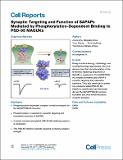| dc.contributor.author | Zhu, Jinwei | |
| dc.contributor.author | Zhou, Qingqing | |
| dc.contributor.author | Shang, Yuan | |
| dc.contributor.author | Li, Hao | |
| dc.contributor.author | Peng, Mengjuan | |
| dc.contributor.author | Ke, Xiao | |
| dc.contributor.author | Weng, Zhuangfeng | |
| dc.contributor.author | Zhang, Rongguang | |
| dc.contributor.author | Huang, Xuhui | |
| dc.contributor.author | Li, Shawn S.C. | |
| dc.contributor.author | Feng, Guoping | |
| dc.contributor.author | Lu, Youming | |
| dc.contributor.author | Zhang, Mingjie | |
| dc.date.accessioned | 2018-04-24T17:27:25Z | |
| dc.date.available | 2018-04-24T17:27:25Z | |
| dc.date.issued | 2017-12 | |
| dc.date.submitted | 2017-11 | |
| dc.identifier.issn | 2211-1247 | |
| dc.identifier.uri | http://hdl.handle.net/1721.1/114936 | |
| dc.description.abstract | The PSD-95/SAPAP/Shank complex functions as the major scaffold in orchestrating the formation and plasticity of the post-synaptic densities (PSDs). We previously demonstrated that the exquisitely specific SAPAP/Shank interaction is critical for Shank synaptic targeting and Shank-mediated synaptogenesis. Here, we show that the PSD-95/SAPAP interaction, SAPAP synaptic targeting, and SAPAP-mediated synaptogenesis require phosphorylation of the N-terminal repeat sequences of SAPAPs. The atomic structure of the PSD-95 guanylate kinase (GK) in complex with a phosphor-SAPAP repeat peptide, together with biochemical studies, reveals the molecular mechanism underlying the phosphorylation-dependent PSD-95/SAPAP interaction, and it also provides an explanation of a PSD-95 mutation found in patients with intellectual disabilities. Guided by the structural data, we developed potent non-phosphorylated GK inhibitory peptides capable of blocking the PSD-95/SAPAP interaction and interfering with PSD-95/SAPAP-mediated synaptic maturation and strength. These peptides are genetically encodable for investigating the functions of the PSD-95/SAPAP interaction in vivo. Using structural biology, cell biology, and electrophysiology approaches, Zhu et al. demonstrate that phosphorylation of the N-terminal repeating sequences of SAPAPs is required for the SAPAP/PSD-95 complex formation and SAPAP's synaptic targeting and maturation functions. They also developed a potent non-phosphorylated PSD-95 GK inhibitory peptide that can effectively disrupt the SAPAP/PSD-95 complex formation and thus inhibit excitatory synaptic activities. Keywords: GK domain; PSD-95; SAPAP; MAGUK; postsynaptic density; synaptic scaffold proteins; synaptogenesis; synaptic plasticity | en_US |
| dc.publisher | Elsevier | en_US |
| dc.relation.isversionof | http://dx.doi.org/10.1016/J.CELREP.2017.11.107 | en_US |
| dc.rights | Attribution-NonCommercial 4.0 International (CC BY-NC 4.0) | en_US |
| dc.rights.uri | https://creativecommons.org/licenses/by-nc-nd/4.0/ | en_US |
| dc.source | Cell Reports | en_US |
| dc.title | Synaptic Targeting and Function of SAPAPs Mediated by Phosphorylation-Dependent Binding to PSD-95 MAGUKs | en_US |
| dc.type | Article | en_US |
| dc.identifier.citation | Zhu, Jinwei et al. “Synaptic Targeting and Function of SAPAPs Mediated by Phosphorylation-Dependent Binding to PSD-95 MAGUKs.” Cell Reports 21, 13 (December 2017): 3781–3793 © 2017 The Author(s) | en_US |
| dc.contributor.department | Massachusetts Institute of Technology. Department of Brain and Cognitive Sciences | en_US |
| dc.contributor.department | McGovern Institute for Brain Research at MIT | en_US |
| dc.contributor.mitauthor | Feng, Guoping | |
| dc.relation.journal | Cell Reports | en_US |
| dc.eprint.version | Final published version | en_US |
| dc.type.uri | http://purl.org/eprint/type/JournalArticle | en_US |
| eprint.status | http://purl.org/eprint/status/PeerReviewed | en_US |
| dc.date.updated | 2018-04-20T18:54:35Z | |
| dspace.orderedauthors | Zhu, Jinwei; Zhou, Qingqing; Shang, Yuan; Li, Hao; Peng, Mengjuan; Ke, Xiao; Weng, Zhuangfeng; Zhang, Rongguang; Huang, Xuhui; Li, Shawn S.C.; Feng, Guoping; Lu, Youming; Zhang, Mingjie | en_US |
| dspace.embargo.terms | N | en_US |
| dc.identifier.orcid | https://orcid.org/0000-0002-8021-277X | |
| mit.license | PUBLISHER_CC | en_US |
